There are many different sim-racing set-ups, and each person has his or her own preferences. Some opt for the minimum with steering wheel and pedals, while others prefer a complete setup, adding a gearshift, handbrake, cockpit and so on. Obviously, this differs from case to case, but the main motivators are the degree of immersion and the budget.
Sim-racing is like buying a car: you do it according to your needs and the amount of money you feel is adequate to put into a setup. If you’ve got the inclination and the means, you can buy a top-of-the-range model, complete with cockpit, all peripherals, multiple screens, jacks and so on. But if you don’t have much free time to devote to this discipline, nor the budget, you won’t go for the very top of the range.
Personally, a sim-racing setup without pedals makes no sense. I’m not going to invest my time and money to cut sensations and immersion in half. Nor am I going to accelerate and brake with buttons or paddles. If I wanted to do that, I’d stick to my good old controller. I want the immersion, the sensations, the feel of a racing car, and that’s why a sim-racing setup without pedals is simply unthinkable.
In this article, I’m going to introduce you to the best sim-racing pedalboards currently on the market. I’m only going to focus on two entry-level products, and two top-of-the-range ones.
The Fanatec CSL Pedals LC
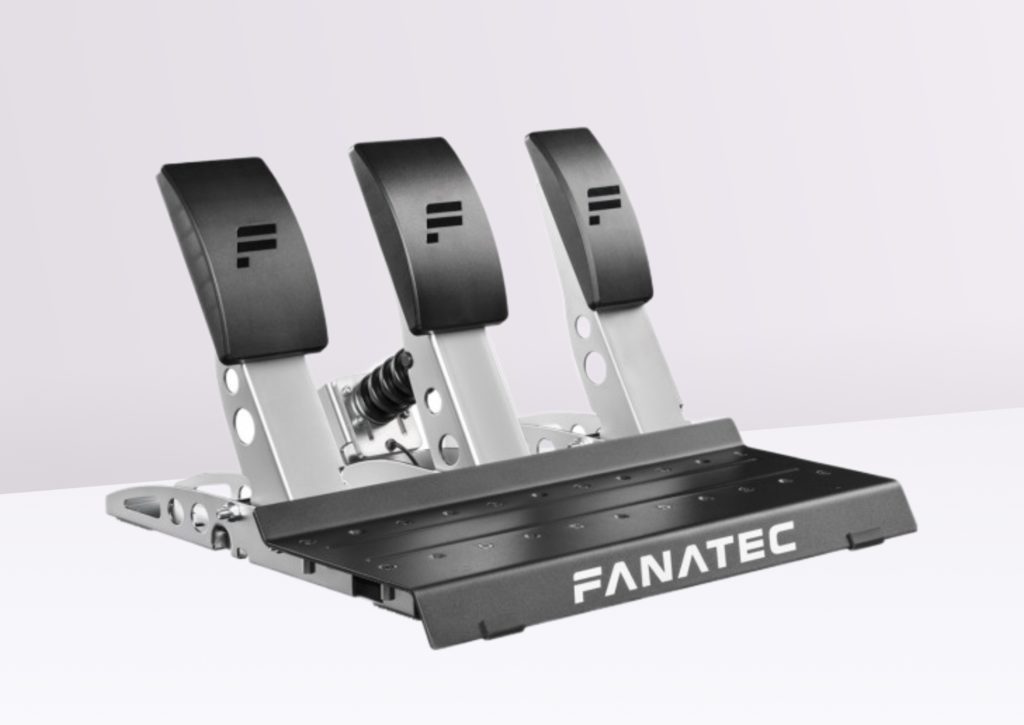
Advantages :
- Adjustable pedals
- Configurable brake load (Load Cell)
- Attractive price
- Solid construction
Disadvantages :
- Slight dead zone in the pedals
I’ll start with a product that I think is excellent for its price, the Fanatec CSL Elite Pedals LC. This device has 3 pedals and is built with solid materials (aluminum). The pedals are covered with rubber sleeves to ensure grip and prevent damage to the metal underneath. It’s like being in a real car, and I love it.
Each pedal is horizontally adjustable to suit the sim-racer, which is quite rare for an entry-level product, but Fanatec always has something extra over the competition. Also, the brake pedal has a Load Cell that supports up to 90 kg of force, and is configurable. This means you can adjust the braking force to your liking, and I love it.
Overall, this is an excellent pedalboard for just €200 that will work on all platforms (PC and console). However, it is not without its faults. The first is that it comes disassembled, which means you have to assemble it yourself. This wasn’t a problem for me, but others may not appreciate it. Secondly, as this is an entry-level product, there is a dead zone on all 3 pedals. Small impulses of one millimeter will not be registered by the device. It’s a shame. But it’s still an excellent product for those wishing to get into the discipline, as well as amateurs.
In terms of compatibility, this pedalboard will work perfectly with other Fanatec products, such as the manufacturer’s bases.
The Thrustmaster T-LCM
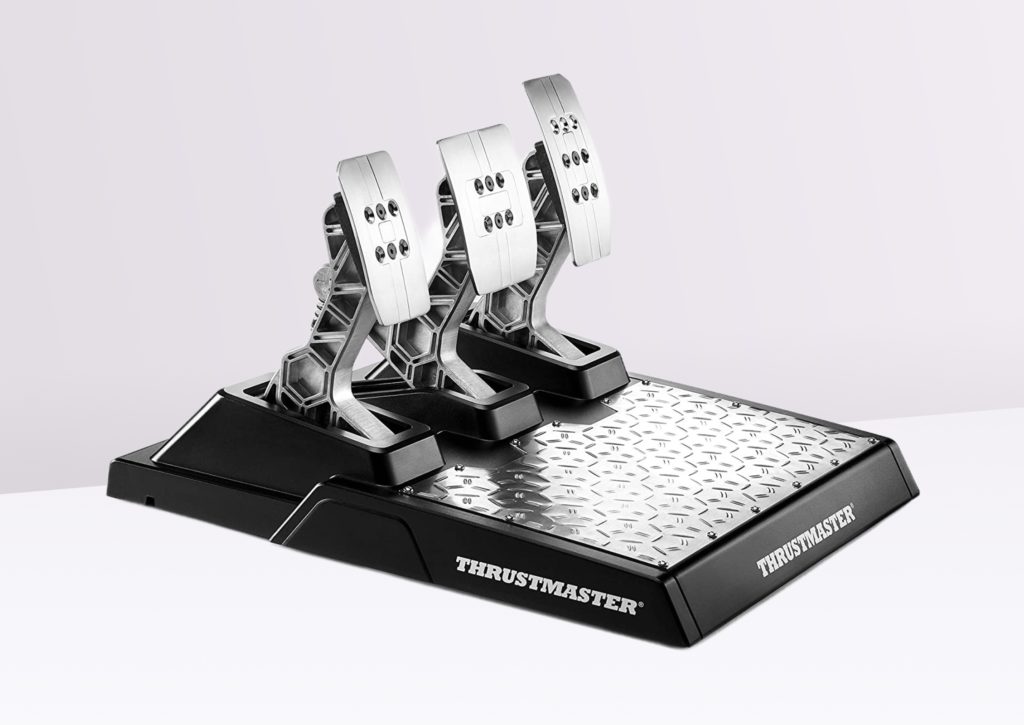
Advantages :
- Attractive price
- Braking load up to 100 kg
- Different settings
Disadvantages :
- Hardly any
Second entry, the Thrustmaster T-LCM. Like the Fanatec we saw first, this pedalboard costs less than €200, making it an excellent product. The materials chosen are of good quality (metal), and the sensations are spot on.
I really like the fact that Thrustmaster includes 6 different springs for adjusting the brake pedal, just what you want and how you feel. What’s more, with the Load Cell’s 100 kg maximum load-bearing capacity, it’s an excellent pedal set for heavy braking without plugging in.
The construction is metal, as is customary with this type of sim-racing peripheral, and it’s excellent. Unlike the Fanatec CSL Elite, the Thrustmaster T-LCM has no rubber covering on the pedals. It’s all metal, with no middle ground. Also, I noticed that the Thrusmaster is a little big, but this is by no means a problem. On the contrary, the wide footrest area is excellent, leaving me both comfortable and close to the pedals.
If you’re looking for drawbacks to this peripheral, I haven’t found any. For its price (in the €180 range), it’s just perfect, whether for amateurs or fans of sim-racing. It’s a must-have for any configuration.
Read my full review of the Thrustmaster T-LCM.
The Heusinkveld Sim Pedals Ultimate
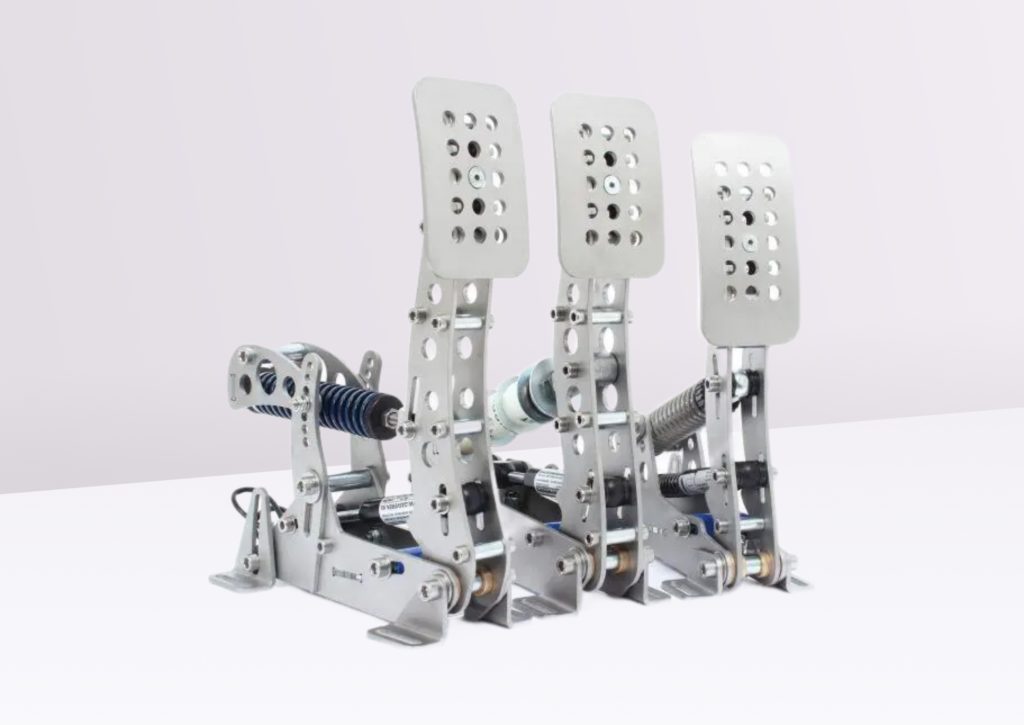
Advantages :
- Hydraulic shock absorber
- All-metal construction
- Available with 2 or 3 pedals
Disadvantages :
- Very premium prices
I would now like to turn to what I consider to be a top-of-the-range device, the Heusinkveld Sim Pedals Ultimate. To put it simply: when using this sim-racing pedalboard, the difference between its feel and that of a racing car is extremely slight, and some of you won’t even know the difference.
This pedal set is made entirely of metal (aluminum) to offer unrivalled rigidity in the segment. It’s just a piece of goldsmith’s work. And to top it all off, the maximum braking force is 200 kg, twice as much as the pedals we’ve just seen.
Unlike the others, the Heusinkveld Sim Pedals Ultimate offers immediate pedal response, with no dead zones or anything else. It’s downright exhilarating. Of course, all this comes at a price. The Heusinkveld Sim Pedals Ultimate is priced at just over €1,000 in 3-pedal configuration, and less than €900 in 2-pedal configuration. As far as I’m concerned, I’d recommend going for the 2-pedal version if you don’t want to add a shifter to your setup, unless you’re a drift fan.
Also, this pedal set is more geared towards motorsports professionals rather than sim-racing fans, both in terms of price and build quality.
Read my full review of the Heusinkveld Sim Pedals Ultimate+.
SIMTAG Hydraulic
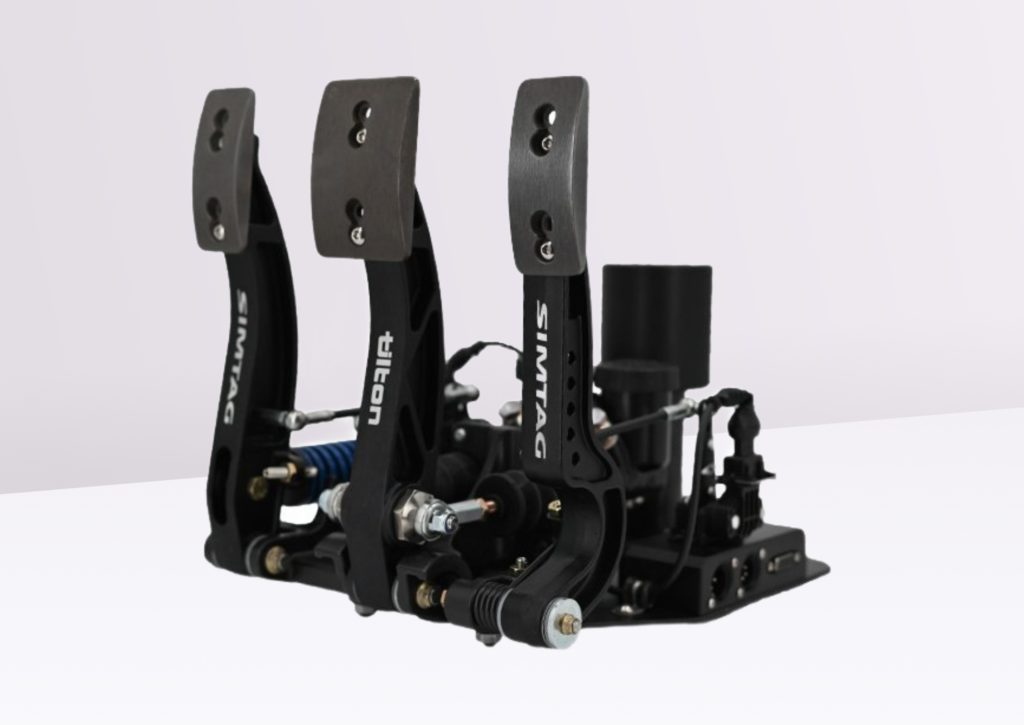
Advantages :
- Complete hydraulic system
- Pedal positioning sensor
- Outstanding manufacturing quality
Disadvantages :
- Very high price, especially on the 3-pedal version
Let’s get down to business. Let me introduce you to the SIMTAG Hydraulica pedal set which, as its name suggests, is hydraulic. To put it simply, there are currently two types of pedals in sim-racing: those with Load Cells and those with hydraulic systems.
Load Cell pedals are simply pedals with springs/dampers that allow braking forces of up to 200 kg for certain peripherals. It looks good on paper, and in practice it’s quite realistic, given that manufacturers always include several springs and other accessories to adjust the braking feel.
As far as hydraulic pedals are concerned, these are much closer to the braking systems on cars, which are also hydraulic. And the SIMTAG Hydraulic is, and I really think it is, the best sim-racing braking system.
Like many other manufacturers of high-end peripherals, SIMTAG uses technologies and systems taken directly from racing, and this is the case with this pedal set. It’s made from forged aluminum, which is known to be ultra-strong even under the heaviest braking.
The hydraulic system is not just for the brake pedal, but for all the pedals on the device, ensuring precision, feel and consistency when you press your foot down to accelerate, brake or clutch.
Honestly, there’s nothing better on the market as far as I’m concerned, except perhaps the Simucube ActivePedal, but that product is in a different range, intended mainly for F2, F3, GT3, etc. teams.
A hydraulic system for a pedal set is expensive, especially if you do it on all 3 pedals and add top-of-the-range sensors from Bosch. How much does the SIMTAG Hydraulic cost? Well, no less than €1,200 for the 2 pedals, and almost double that for the 3 pedals. A configuration with this type of system can easily top €10,000.
Which one to choose?
As with a steering wheel or a base, the first step is to understand your needs. If you’re a weekend warrior, doing your sim-racing on Forza or Gran Turismo, you don’t need to go for the top-of-the-range SIMTAG Hydraulic with its hydraulic system. A Load Cell pedal set is more than sufficient for this kind of set-up.
However, here are my recommendations for choosing a pedalboard.
- Budget. As I always say, you first need to specify a budget for a peripheral that you don’t want to exceed. There’s no point in researching a pedalboard costing over €1,000 if you only have €200 for this kind of sim-racing peripheral. Set a budget for a pedalboard based on the other peripherals you also have (steering wheel, base, shifter, screen, etc.).
- Availability. Many products are available, or distributed, via popular retailers such as Boulanger, Darty, Amazon and so on. So, if you want a pedalboard that’s available straight away, try brands like Thrusmaster and Logitech, which offer excellent sim-racing peripherals at reasonable prices. Names like Fanatec and Simucube only sell via their store, which can cause stock availability problems.
- Compatibility. Always try to stay within a single ecosystem for the best possible compatibility. I should point out that some sim-racing manufacturers, such as Fanatec or Simucube, offer product ranges that are not compatible with consoles. Typically, top-of-the-range or even very top-of-the-range sim-racing peripherals are only compatible on PC, for the simple reason that it’s the only platform capable of pushing FPS to the max, and also because of the greater availability of sim-racing games.
- Feeling. So, this point is related to the first, budget. If you want a good pedal feel, you can’t beat Load Cell pedals for value for money. Hydraulic systems alone are in a much higher range, typically aimed at hardcore sim-racing fans and racing professionals.
Pedalboards are an essential part of sim-racing setups, along with steering wheels and bases. It’s simple: if you don’t use pedalboards, you’ll have virtually no feeling at all. It’s like driving an electric car; sure, it goes fast, but the driving feel and sensations just aren’t there.

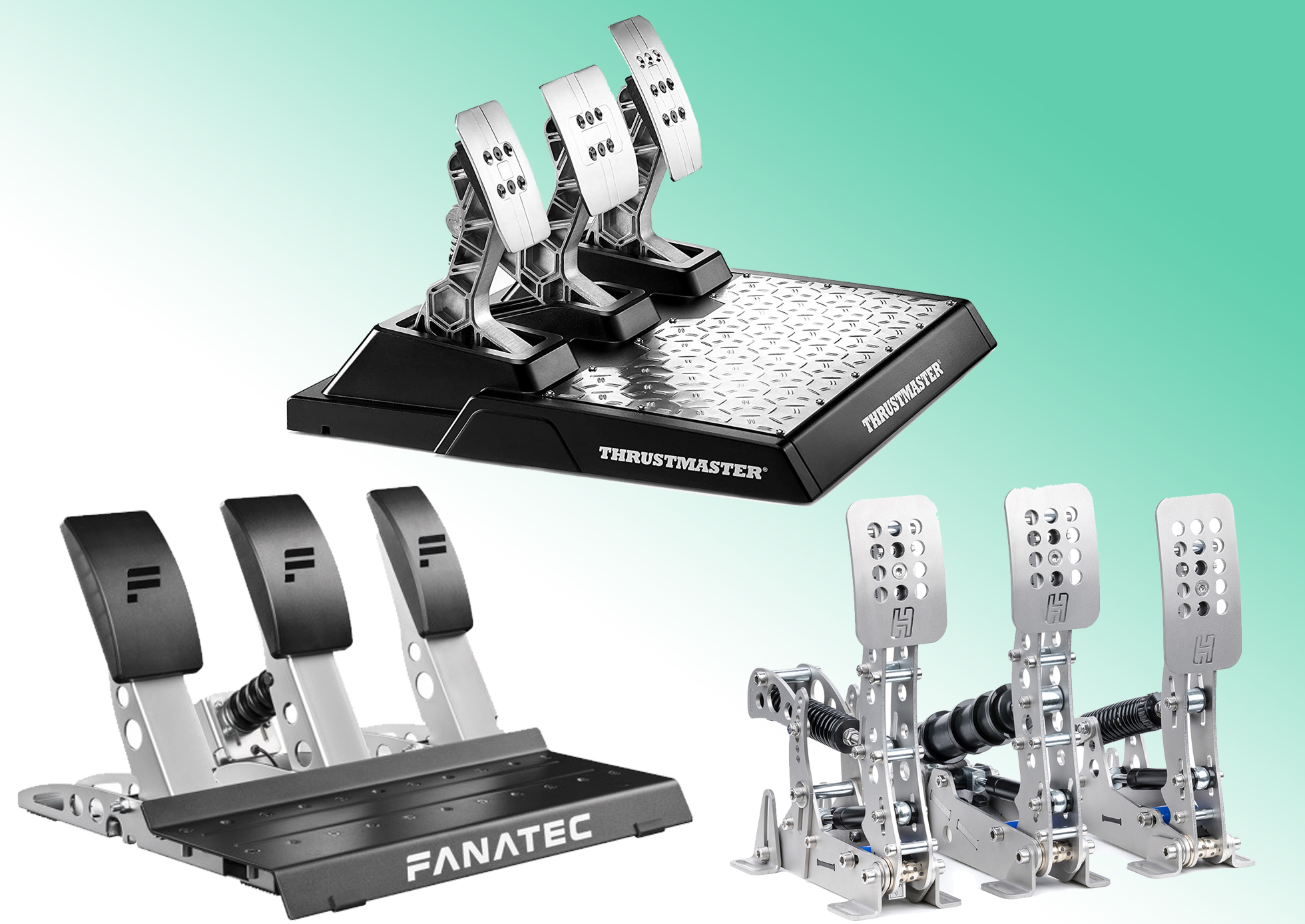
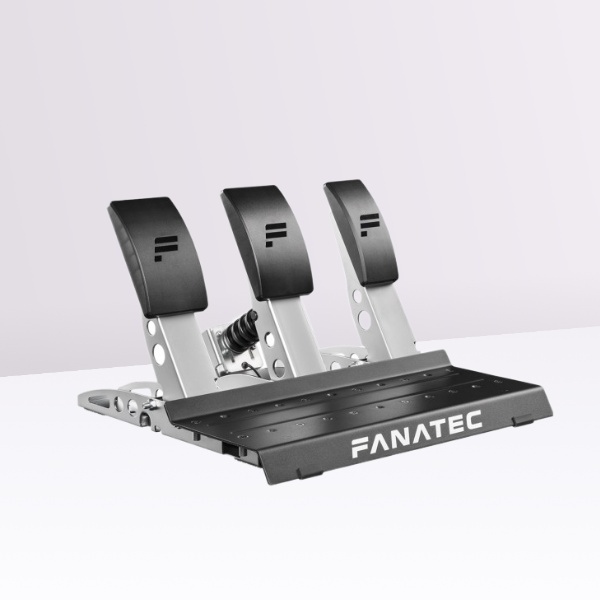
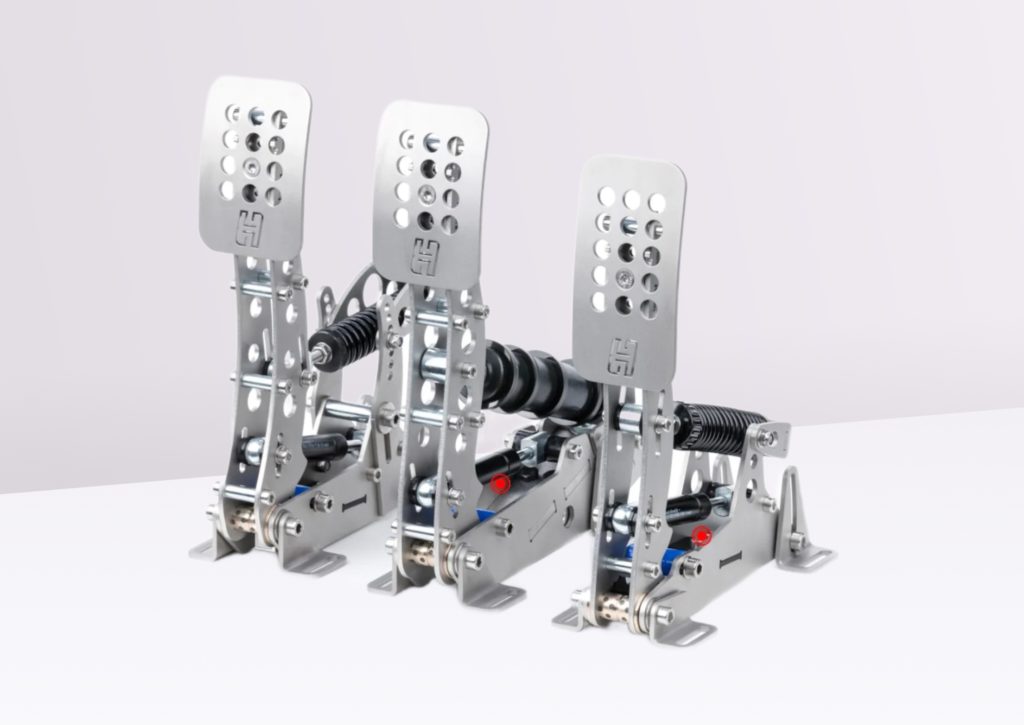
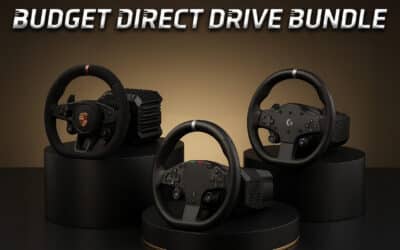
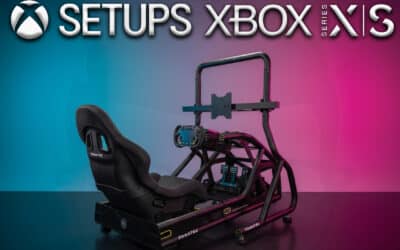

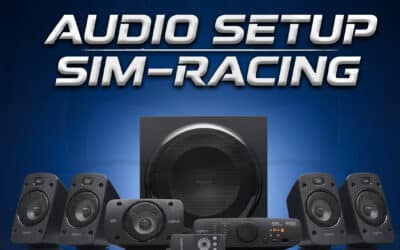

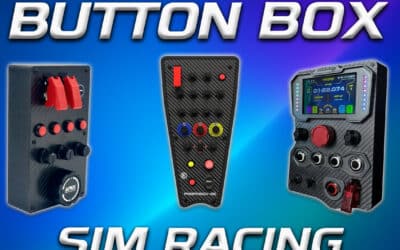
0 Comments